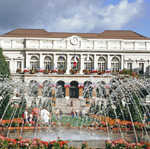
Michel Thiollière, Mayor of St Etienne and French Senator

FRONT PAGE
About us

The 2010 results
The 2010 project
The 2010 finalists
Code of Ethics
The World Mayor Prize

The 2008 results
The 2008 project
The 2008 finalists
The World Mayor Award

The 2006 results
Methodology
The 2006 finalists
The World Mayor Award
Dora Bakoyannis congratulates John So
With Mayor of Amsterdam
With Mayor of Harrisburg
With Mayor of Melbourne
With Mayor of St Etienne

Mayor of Amsterdam
Mayor of Antananarivo
Mayor of Augsburg
Mayor of Denver
Mayor of Dubrovnik
Mayor of Harrisburg
Mayor of Makati City
Mayor of Melbourne
Mayor of St Etienne
Mayor of Valencia

On Mayor of Amsterdam
On Mayor of Antananarivo
On Mayor of Augsburg
On Mayor of Bangalore
On Mayor of Belo Horizonte
On Mayor of Denver
On Mayor of Dubrovnik
On Mayor of Harrisburg
On Mayor of Houston
On Mayor of Istanbul
On Mayor of Makati City
On Mayor of Melbourne
On Mayor of Mulhouse
On Mayor of New Orleans
On Mayor of New York
On Mayor of Phnom Penh
On Mayor of Sofia
On Mayor of St Etienne
On Mayor of Taipei
On Mayor of Toronto
On Mayor of Valencia (VE)

By Mayor of Amsterdam
By Mayor of Augsburg
By Mayor of Belo Horizonte
By Mayor of Dubrovnik
By Mayor of Makati City
By Mayor of Melbourne
By Mayor of Valencia

The 2005 results
Contest methodology
List of finalists
Winning mayors write
Mayor Rama writes - Mayor Bakoyannis replies

The 2004 contest
List of all 2004 finalists
Edi Rama wins 2004 award
People ask - Edi Rama replies

Front Page
Site Search
About City Mayors
Michel Thiollière
Mayor of St Etienne, France
After becoming Mayor of Saint-Etienne and President of its Urban Community (a federation that includes 43 districts and almost 400,000 inhabitants) Michel Thiollière lost no time in launching a major urban renewal project. This would go on to profoundly change the face of the city, allowing both its service sector and cultural and architectural assets to assume their full potential. In 2006 Michel Thiollière was included among the top ten mayors in the annual World Mayor project.
The city has been marked by the upheavals caused by 200 years of industrial revolution. It has also suffered the effects of crises in the mining and metalworking industries. Against this background, Michel Thiollière’s optimistic style has shone through - often contrary to the local mood. On assuming office he quickly set in motion his restructuring plans, making his imprint as a visionary, or more simply as somebody with the capacity to shape the future.
His action has been based upon major projects to improve the structural fabric of the town and to give it the means to expand and develop. In all of this, initiatives to boost the arts as a vehicle for development as well as social cohesion were not forgotten. Today a number of major projects are helping to transform the image and influence of Saint-Etienne and its surrounding area.
The underlying objective of the renovation and construction that is going on is to combine the charm and nostalgia of the past with a modern, attractive environment while maintaining a healthy balance between respect for people as individuals and administering the community as a whole.
One major guiding theme has emerged from it all - the Saint-Etienne Métropole Design. Saint-Etienne and its urban area can draw upon a strong tradition in the industrial and artistic fields, combining cultural creativity and technological innovation. One of its objectives is the Cité du Design (Design Village).
This strategy is based upon the existence of a thriving cultural scene including the presence of the Museum of Modern Art, which houses France's leading modern art collection outside Paris, the International Biennial Design Festival, and famous sites such as the Le Corbusier site in Firminy and the proposed first Zenith music and cultural centre of the Rhône-Alpes. Named in 2000 as a Town of Art and History, Saint-Etienne is today a candidate for the status of a European Culture Capital in 2013.
Michel Thiollière has a unique style, displaying a high degree of determination and openness, whether concerning people, other French regions or the international scene. He daily demonstrates his ability to unite people around an idea, regardless of their political viewpoints.
His commitment to innovation and creativity has also attracted some of the greatest names in contemporary architecture, including Fumihiko Maki (now working on a vast urban renewal project in the town centre) and Sir Norman Foster (currently designing the future Zenith entertainment venue).
In addition to his willingness to listen and to engage in dialogue, he also possesses the ability to inspire confidence and faith in the town and in its inhabitants. He is politically courageous, determined and demanding. But he is also careful to explain each of his ideas in detail in order to ensure their success. Michel Thiollière firmly believes that Saint-Etienne now stands at the crossroads, and that thanks to clear vision and much long-term work the city can finally make the transition it so desperately needs.

St Etienne City Hall
Short history
of St Etienne
Saint-Etienne is situated on the eastern edge of the Massif Central in the south of the Loire region and at the heart of an area populated by 450,000 people, and stretches out between the valleys and hills.
In the Middle Ages it was no more than a village. During the Ancien Régime Saint-Étienne was a town of fewer than 30,000 people. The existence of coal and a great many streams made it possible for the town to establish the foundations of its industrialisation during the 15th and 16th centuries. This took the form of developing its arms, cutlery, weaving and dyeing industries.
The Industrial Revolution provided the means for considerable development and Saint-Etienne became France’s leading major industrial town during the 19th Century. By focusing on know-how and tremendous innovation, Saint-Etienne has since become dedicated to industrial creation and design.
While manufacturers of furnishing trimmings, armourers and cycle manufacturers may have played the biggest parts in the economic life of the region over the ages, its inhabitants were also pioneers in industrial design. Design, combined with the desire to spread their ideas abroad, thus quietly became a part of everyday life for its creative inhabitants.
Saint-Etienne has always known how to preserve the necessary dialogue between art and industry, as illustrated by the initiative shown by its industries, which, since 1857 have looked in particular towards the region’s Art School as a means of improving their products and for inventing new ones.
The fact that most of its inhabitants were labourers ensured that immigrants were especially welcomed into the mining and other heavy industries. As a result, a feeling of conviviality in everyday life emerged. This is demonstrated by the dynamism of the town, which is a candidate for the European Capital of Culture, as well as by Sir Norman Foster’s construction of the Rhône Alpes Zenith.
Various cultural sites serve as a reminder to this tradition, including the Museum of Art and Industry, the Mining Museum, the Museum of Modern Art as well as the architectural heritage of Le Corbusier in Firminy.
Design is a part of Saint-Etienne’s history, and it is also set to be a part of its future. Design and engineering have won such acclaim that these concepts constitute a leading part of the town’s cultural and economic landscape. This can readily be seen in ambitious projects such as the Cité de Design (City of Design), the Pole Optique Rhône-Alpes (the Rhône-Alpes optics centre) and Fumihiko Maki’s Cité des affaires (business city).
